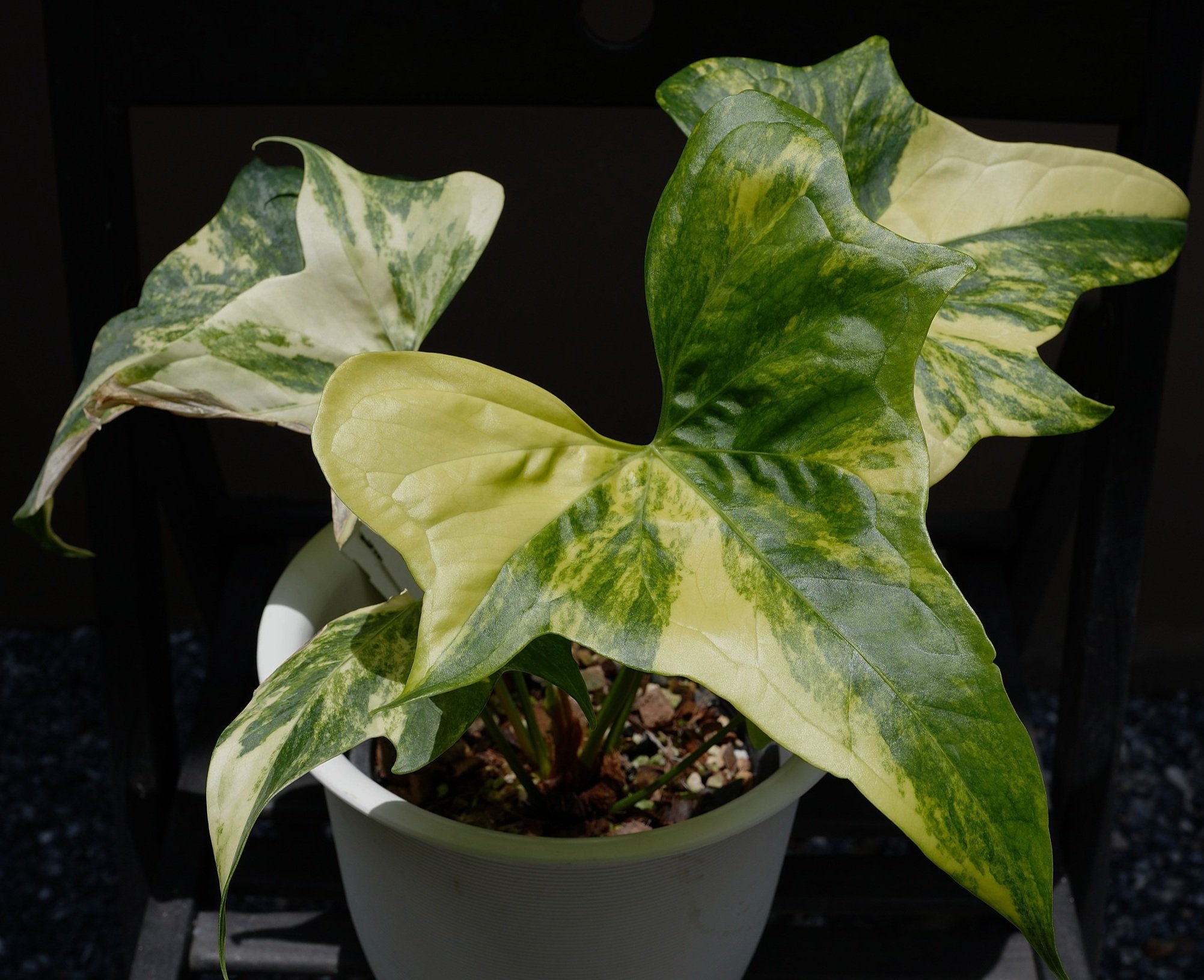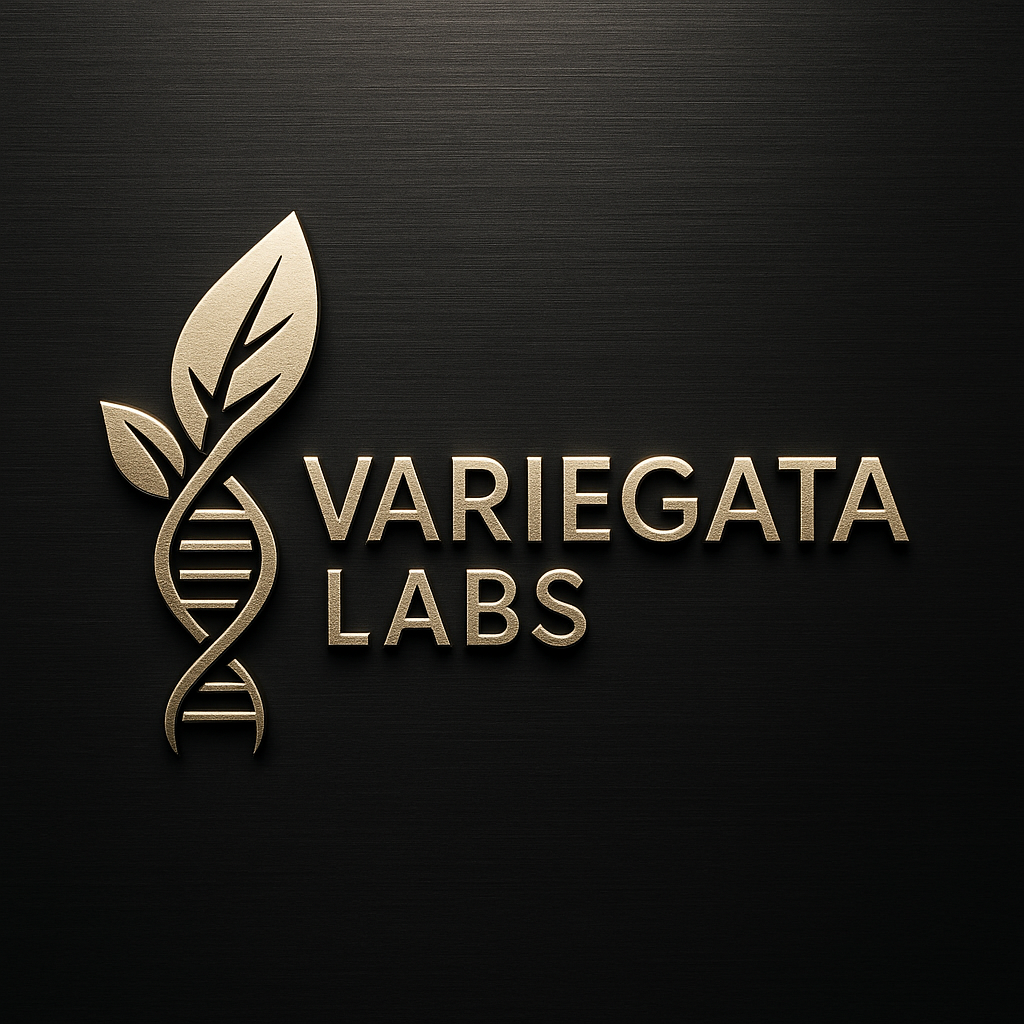 Image 1 of 1
Image 1 of 1


Anthurium pterodactyl 'Variegata'
Anthurium pterodactyl 'Variegata'
The Prehistoric Beauty
Wings of Wonder in Your Collection
Step into the Jurassic age of houseplants with the extraordinary Anthurium pterodactyl 'Variegata' - a plant so uniquely stunning it looks like it flew straight out of prehistoric times. This remarkable specimen combines the ancient mystique of its namesake with striking variegated foliage that makes every leaf a conversation starter. Once a rare collector's treasure commanding premium prices, tissue culture technology has made this prehistoric beauty more accessible than ever, bringing Jurassic-era elegance to modern plant collections.
Prehistoric Elegance Meets Modern Appeal
The Anthurium pterodactyl 'Variegata' lives up to its dramatic name with green leaves and pale-green, almost silver veining, with veins shaped in a way that resemble skeletal wings, like a Pterodactyl in flight. But the variegated form takes this prehistoric beauty to another level entirely. The leaves have striking variegation, with distinctive variegation patterns and prehistoric-inspired leaves that showcase large, elongated leaves that resemble the wings of a pterodactyl.
The variegated version displays stunning cream to white sectoral variegation dancing across the already dramatic wing-shaped leaves. Each leaf emerges as a unique masterpiece, with variegated sections highlighting the intricate vein patterns that give this plant its prehistoric character. As the plant matures, these wing-like leaves can reach impressive sizes, creating a bold statement piece that commands attention in any plant collection.
The TC Advantage - Prehistoric Genetics Made Accessible
Our tissue culture Anthurium pterodactyl 'Variegata' represents a breakthrough in rare plant accessibility. Tissue culture has proven to be an influential tool that can complement conventional breeding and accelerate Anthurium development, overcoming the demerits of conventional propagation. This advanced propagation method ensures every plant carries the genetic markers for both the distinctive pterodactyl leaf shape and the coveted variegation.
TC plants arrive completely pest-free and disease-free, with robust root systems ready to establish quickly in your home environment. Unlike the unpredictable nature of cutting-propagated variegated anthuriums, tissue culture ensures consistent quality and reliable variegation patterns from day one. The controlled laboratory environment produces stronger, more vigorous plants that adapt better to home conditions.
Care & Growth Requirements
Light: Anthurium do best in a well lit, bright area, out of direct sunlight. For the variegated form, provide bright, indirect light (10,000-20,000 lumens) to maintain vibrant variegation while preventing leaf scorch on the white sections.
Watering: The Anthurium Pterodactyl needs to ideally dry out a little between waterings -- but it prefers to be kept pretty evenly moist, at the same time! Water when the top 1-2 inches are dry and maintain consistent soil moisture without waterlogging. The variegated sections are more sensitive to both drought and overwatering.
Humidity: Maintain 60-70% humidity for optimal growth and to prevent browning of variegated leaf edges. Use a humidifier, pebble tray, or group with other tropical plants to create a suitable microclimate.
Temperature: Guarantee temperatures remain between 65-75°F (18-24°C) with stable conditions. Avoid temperature fluctuations that can stress the plant and affect variegation development.
Soil: Use a well-draining, chunky aroid mix with orchid bark, perlite, and sphagnum moss. Excellent drainage is crucial as anthuriums are naturally epiphytic and sensitive to waterlogged conditions.
Growth Habit: This compact anthurium maintains a clumping growth habit rather than climbing. The dramatic wing-shaped leaves emerge from a central crown, creating a stunning rosette of prehistoric foliage.
Pro Tips
Variegation Maximization: Consistent bright, indirect light is key to maintaining strong variegation patterns. Rotate your plant weekly to ensure even light exposure and prevent the plant from becoming lopsided as it reaches toward the light source.
Collector's Investment: The pterodactyl variegata represents one of the more unusual and conversation-worthy additions to any aroid collection. Its unique leaf shape combined with variegation makes it a standout specimen that often becomes the focal point of plant displays.
Propagation Possibilities
Can be propagated through stem cuttings placed in water or directly into soil. However, propagation of variegated anthuriums can be challenging, and there's no guarantee that new plants will retain the parent's variegation patterns. Division of the main plant when multiple crowns develop is often more successful for maintaining variegation.
Most successful propagations occur when the plant naturally produces offsets or when careful division of established clumps is performed. Water propagation typically takes 4-6 weeks for root development in warm, humid conditions.
Pet Safety
⚠️ Toxic to pets and humans. All parts of Anthurium plants contain calcium oxalate crystals that can cause mouth irritation, difficulty swallowing, and digestive upset if ingested. Keep away from curious pets and children.
The Prehistoric Revolution
The Anthurium pterodactyl 'Variegata' represents the perfect fusion of prehistoric drama and modern botanical beauty. This low-maintenance Aroid makes it a fun collector plant that brings Jurassic-era mystique to contemporary plant collections. What once required hunting down rare specimens from specialized collectors is now accessible through tissue culture technology.
Whether you're drawn to its prehistoric aesthetic, fascinated by its unique variegation patterns, or simply want to add something truly extraordinary to your collection, the tissue culture pterodactyl variegata delivers unmatched visual impact. This is your opportunity to own a living fossil - a plant that looks like it evolved alongside the dinosaurs but thrives in modern homes.
Every leaf tells a story of ancient times while showcasing the cutting-edge science that makes rare plant collecting accessible to passionate plant parents everywhere. The pterodactyl variegata isn't just a houseplant - it's a conversation piece, a work of living art, and a testament to the incredible diversity of the plant kingdom.
Anthurium pterodactyl 'Variegata'
The Prehistoric Beauty
Wings of Wonder in Your Collection
Step into the Jurassic age of houseplants with the extraordinary Anthurium pterodactyl 'Variegata' - a plant so uniquely stunning it looks like it flew straight out of prehistoric times. This remarkable specimen combines the ancient mystique of its namesake with striking variegated foliage that makes every leaf a conversation starter. Once a rare collector's treasure commanding premium prices, tissue culture technology has made this prehistoric beauty more accessible than ever, bringing Jurassic-era elegance to modern plant collections.
Prehistoric Elegance Meets Modern Appeal
The Anthurium pterodactyl 'Variegata' lives up to its dramatic name with green leaves and pale-green, almost silver veining, with veins shaped in a way that resemble skeletal wings, like a Pterodactyl in flight. But the variegated form takes this prehistoric beauty to another level entirely. The leaves have striking variegation, with distinctive variegation patterns and prehistoric-inspired leaves that showcase large, elongated leaves that resemble the wings of a pterodactyl.
The variegated version displays stunning cream to white sectoral variegation dancing across the already dramatic wing-shaped leaves. Each leaf emerges as a unique masterpiece, with variegated sections highlighting the intricate vein patterns that give this plant its prehistoric character. As the plant matures, these wing-like leaves can reach impressive sizes, creating a bold statement piece that commands attention in any plant collection.
The TC Advantage - Prehistoric Genetics Made Accessible
Our tissue culture Anthurium pterodactyl 'Variegata' represents a breakthrough in rare plant accessibility. Tissue culture has proven to be an influential tool that can complement conventional breeding and accelerate Anthurium development, overcoming the demerits of conventional propagation. This advanced propagation method ensures every plant carries the genetic markers for both the distinctive pterodactyl leaf shape and the coveted variegation.
TC plants arrive completely pest-free and disease-free, with robust root systems ready to establish quickly in your home environment. Unlike the unpredictable nature of cutting-propagated variegated anthuriums, tissue culture ensures consistent quality and reliable variegation patterns from day one. The controlled laboratory environment produces stronger, more vigorous plants that adapt better to home conditions.
Care & Growth Requirements
Light: Anthurium do best in a well lit, bright area, out of direct sunlight. For the variegated form, provide bright, indirect light (10,000-20,000 lumens) to maintain vibrant variegation while preventing leaf scorch on the white sections.
Watering: The Anthurium Pterodactyl needs to ideally dry out a little between waterings -- but it prefers to be kept pretty evenly moist, at the same time! Water when the top 1-2 inches are dry and maintain consistent soil moisture without waterlogging. The variegated sections are more sensitive to both drought and overwatering.
Humidity: Maintain 60-70% humidity for optimal growth and to prevent browning of variegated leaf edges. Use a humidifier, pebble tray, or group with other tropical plants to create a suitable microclimate.
Temperature: Guarantee temperatures remain between 65-75°F (18-24°C) with stable conditions. Avoid temperature fluctuations that can stress the plant and affect variegation development.
Soil: Use a well-draining, chunky aroid mix with orchid bark, perlite, and sphagnum moss. Excellent drainage is crucial as anthuriums are naturally epiphytic and sensitive to waterlogged conditions.
Growth Habit: This compact anthurium maintains a clumping growth habit rather than climbing. The dramatic wing-shaped leaves emerge from a central crown, creating a stunning rosette of prehistoric foliage.
Pro Tips
Variegation Maximization: Consistent bright, indirect light is key to maintaining strong variegation patterns. Rotate your plant weekly to ensure even light exposure and prevent the plant from becoming lopsided as it reaches toward the light source.
Collector's Investment: The pterodactyl variegata represents one of the more unusual and conversation-worthy additions to any aroid collection. Its unique leaf shape combined with variegation makes it a standout specimen that often becomes the focal point of plant displays.
Propagation Possibilities
Can be propagated through stem cuttings placed in water or directly into soil. However, propagation of variegated anthuriums can be challenging, and there's no guarantee that new plants will retain the parent's variegation patterns. Division of the main plant when multiple crowns develop is often more successful for maintaining variegation.
Most successful propagations occur when the plant naturally produces offsets or when careful division of established clumps is performed. Water propagation typically takes 4-6 weeks for root development in warm, humid conditions.
Pet Safety
⚠️ Toxic to pets and humans. All parts of Anthurium plants contain calcium oxalate crystals that can cause mouth irritation, difficulty swallowing, and digestive upset if ingested. Keep away from curious pets and children.
The Prehistoric Revolution
The Anthurium pterodactyl 'Variegata' represents the perfect fusion of prehistoric drama and modern botanical beauty. This low-maintenance Aroid makes it a fun collector plant that brings Jurassic-era mystique to contemporary plant collections. What once required hunting down rare specimens from specialized collectors is now accessible through tissue culture technology.
Whether you're drawn to its prehistoric aesthetic, fascinated by its unique variegation patterns, or simply want to add something truly extraordinary to your collection, the tissue culture pterodactyl variegata delivers unmatched visual impact. This is your opportunity to own a living fossil - a plant that looks like it evolved alongside the dinosaurs but thrives in modern homes.
Every leaf tells a story of ancient times while showcasing the cutting-edge science that makes rare plant collecting accessible to passionate plant parents everywhere. The pterodactyl variegata isn't just a houseplant - it's a conversation piece, a work of living art, and a testament to the incredible diversity of the plant kingdom.
